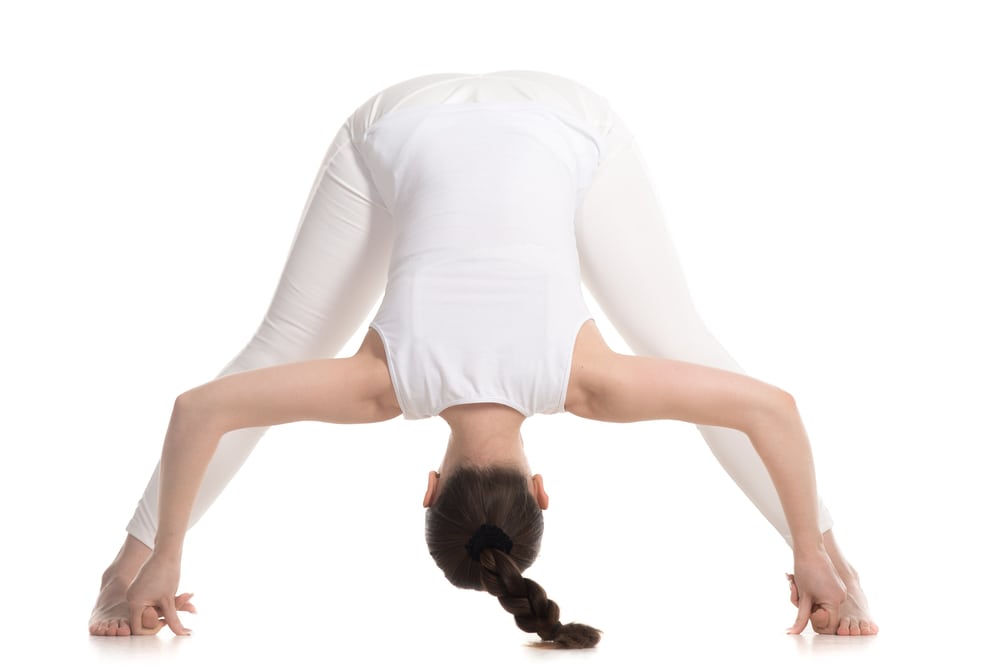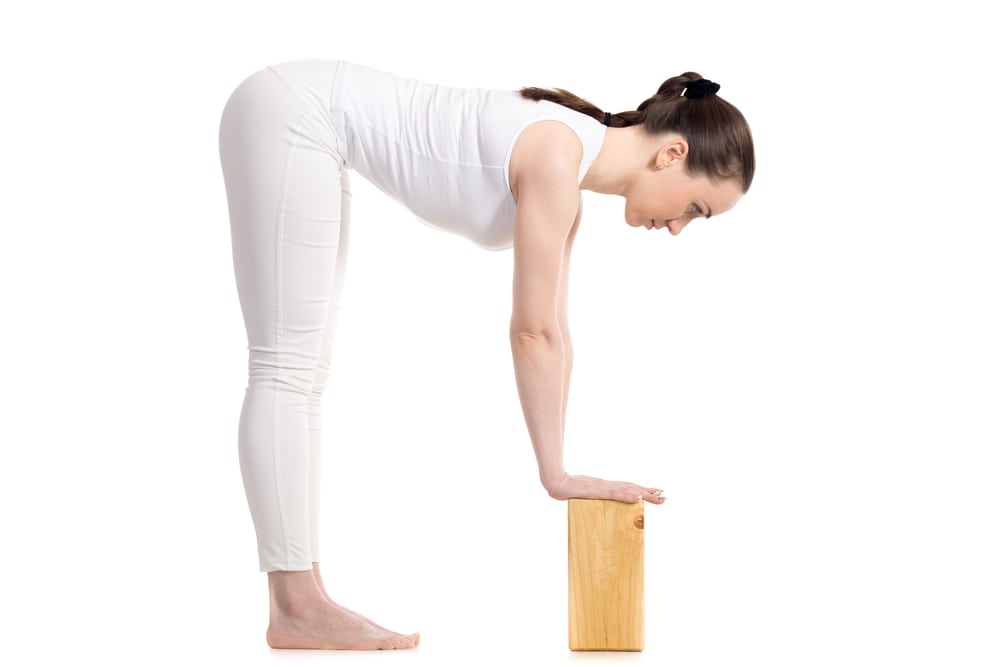

In this lesson, we define alignment and a general approach to teaching it.
Objective
Clearly understand why and how to teach people as opposed to poses, and techniques for empowering students to learn alignment “from the inside.”
Description
Define and discuss the term, “alignment.” Explain the goal of alignment and discuss possible outcomes from healthy alignment, such as joint functioning, the free flow of prana and a sense of mental-emotional-spiritual integration. Consider the differences between the human body and buildings or machines. Explain why no alignment teaching works for all students. Discuss teaching people vs poses and the maturity required to consider principles — not dictate rules. Propose priorities in teaching alignment. Discuss the subject of “proper” alignment. Explore the value in empowering students to learn alignment “from the inside” and how this can be accomplished.

In yoga, alignment refers to how the body is placed in the field of gravity. “Alignment, conceptually, is not good or bad. It’s just a description of how we are arranged in space.” (David Keil)
Alignment often concerns the outer body: bones, muscles, feet, arms, head, etc. It may also refer to the inner body such as organs. The breath is intimately involved in arranging the body in yoga.
The goal of alignment is to support the student’s experience of a pose. It’s typically intended to assist students in exploring in healthy, functional ways, and to avoid injury.
Asanas don’t have alignment — people have alignment. – Leslie Kaminoff link
When a student is experiencing healthy, optimal alignment for that person at that time, they may experience such benefits as:
The metaphors of “building a strong foundation” and “stacking bones” are often quite helpful ways to think about “constructing” a pose. Still, if we imply that such metaphors tell the whole story, we are neglecting a huge part of this experience. Humans are biological systems — not mechanical ones. We are practicing through a mind/body/spirit complex that includes thoughts, emotions, a nervous system, respiratory system, proprioception and so on. We are not buildings!
Be Discerning When Reviewing Establishment “Science” of the Body
Deference to science must be weighed against a healthy amount of discernment. Frankly, doctors and researchers don’t have definitive answers to the questions that arise out of our own experience any more than the gurus did. There is a reason why so many inconclusive test results end up becoming blind referrals to try yoga. The unspoken truth is that on some level what is happening in our bodies is magic. We are mystical beings existing on a planet surrounded by infinite space. When our understanding is capable of holding scientific knowledge with the humility of recognizing all that we do not know at the same time, then perhaps we will begin to better address our dysfunctions and more fully embody the wonder that defines us. – J. Brown, My Body is Not a Machine link
[See also: How Researchers Betray Humanity and How Modern Medicine Betrays Humanity]
Beauty = Anatomically Functional
If alignment is our focus, what we view as “beautiful” then becomes what is anatomically functional… When we see photographs of models hunching or knocking their knees, our first thought may not be admiration, but rather, That looks like it hurts! Our aspiration becomes not to look a certain way, but to be able to move our bones along their intended lines. – Amber Burke, Yoga International, The Pros and Cons of an Alignment-Focused Practice link
Relation Between Inner & Outer Body
Instructions regarding alignment express relationships and set the shape of the pose, the vessel within which the alchemy of yogic action takes place… On a subtler level, alignment extends to the relation between inner and outer body—most specifically, how harmoniously the movement of the breath or prana as an expression of mind and intention complements the posture. If breath and body are in conflict, your practice is missing the kind of inner alignment that really counts, regardless of how your posture appears outwardly. – Doug Keller, Hatha Yoga in the Anusara Style Third Edition link
Different Philosophies & Approaches
My teacher, John Scott, described the Iyengar approach to yoga asana as a function-follows-form approach. That is, in his perspective, Iyengar yoga emphasized lining up parts of the body to create an idealized form of each asana, with the understanding that practitioners would experience the function or action of the pose in deeper ways as they practiced over time. Practitioners supported themselves with props as needed to achieve the ideal form. That approach is different than the Ashtanga style, which John described as a form-follows-function approach. Students in the Ashtanga style were encouraged to allow their pose to be a bit “messier” and prioritize the action or function (opening tissues and creating flexibility) of the pose over the initial form. This was with the understanding that as the student progressed over time, their body would arrive at something closer to the ideal form. Other styles of yoga tend to fall somewhere in between these two approaches to yoga alignment. Both of these approaches to yoga are valid, and neither is better than the other. – David Keil, Yoganatomy, Yoga Alignment: Does It Really Matter? link
Contrasting External Guidance vs Internal Exploration & Embodied Learning
Alignment [from a superficial perspective] is a picture from the outside. It’s composed of aesthetic ideals, spatial relationships between body parts, and precise angles. The kind of embodied learning I discovered in Feldenkrais spoke to my body’s innate sensory systems. The class was guided verbally. Entirely verbally in fact, no demonstrations. But the learning went far beyond following directions of alignment. The cueing was invitational. It left space for personal interpretation. Space that allowed students to feel their way through, problem solve, and guide their own learning. I soon went on to explore other somatic modalities… [and] my studies in physical therapy revealed the ways movement is shaped by sensory stimulation and our relationship with the immediate environment. This branching out resulted in a new found curiosity and creativity in movement practice. – Caitlin Casella, Email Aug 12, 2020

Here we introduce these foundational principles for teaching alignment (the placement of the body).
Aesthetics of the Pose are Secondary
Modern yoga teacher training programs offer many standardized cues for each posture learned. Standards are nice — they make it much easier to learn how to guide students into the large number of poses taught in yoga classes, but unfortunately students are not standardized. There is no average student. The alignment cues absorbed by teacher trainees are approximations; at best they can serve as guidelines but they should never be used as dogmatic requirements. If the student’s intention in taking a yoga class is to regain or maintain optimal health, then postures should serve a functional role, making the aesthetics of the pose secondary, at best. – Bernie Clark, Yoga Journal, 8 Keys to Take Your Yoga Teaching Beyond Standardized Alignment Cues link
Alignment principles and pose cues help teachers learn how to guide students toward their optimal experience. However, in order to systematize something — such as pose cues — there is a simplification, thereby increasing generalizations and lessening a focus on individuality.
When principles are interpreted as “rules,” there is increased danger of ideas being utilized in times that are inappropriate to individuals.
Maturity Requires Outgrowing Generalizations
We cannot teach effectively without some generalizations, but we haven’t reached maturity until we have outgrown generalizations and can competently focus on the unique needs of every student in every pose. This is not an impossible dream—it just takes more time than a teacher training program can afford. The onus of continuing growth is on each and every yoga teacher. – Paul Grilley, Introduction to Your Body, Your Yoga 2016 link
A key technique for teaching people instead of poses is to empower students to learn how to align themselves in healthy ways.
Parts of Us We’ve Been Neglecting, Physically & Otherwise
I learned about “release valves” [while] working in groups, observing other students’ mobility and looking for dysfunctional movement patterns. For example, when one of my classmates shifted into Uttanasana (Standing Forward Fold), you could see that her hips were excessively rotating while her spine seemed awkwardly rigid. She was able to reach her toes because, instead of sharing the load, her flexible hips were doing the work for her stiff back. I quickly started to notice how my own body was compensating for areas that were too tight, too lax, or uncomfortable… These “avoidance mechanisms” … help us understand which parts of us we’ve been neglecting — out of pain, weakness, injury, numbness, shame, or fear. All of a sudden, I started to pay attention to all of the things I had been evading in my life. I noticed I had release valves at the office. I would sit through a meeting, quietly stewing about a decision I didn’t agree with, then head to my desk, venting ungracefully to anyone I ran into. I’m not proud. I was avoiding confrontation and compensating for it with toxic negativity… The relief that comes from embodying balance, creating space to feel my feelings, and finding the courage to speak my truth has started to heal me from the inside out. – Tasha Eichenseher, Yoga Journal, The Avoidance Mechanisms We Have to Face in Order to Heal link
Remember and communicate that the purpose of practicing asana is not to “look good” in a pose, but to optimize health and well-being. Therefore, the priority is function over aesthetics.
Cues Based On Generating Sensations (vs How a Student Looks)
Alignment cues based on how a student looks in a posture is aesthetic yoga; cues based on generating sensation are functional… Each posture [is] a tool to help us generate an appropriate stress: either tension or compression. As a teacher, ask yourself, “what type of stress do I want the student to experience, where and how much?” – Bernie Clark, Yoga Journal, 8 Keys to Take Your Yoga Teaching Beyond Standardized Alignment Cues link
Use these priorities when determining how to address a student’s alignment:

A common opinion equates particular alignment techniques with rightness and safety. J Brown writes here, “I forever come up against the deeply ingrained notion that safety in yoga equals ‘right’ or ‘proper’ alignment.”
This is an easy presumption to make, of course. It feels natural to equate “proper” alignment with a particular accomplishment and/or with safety. But let’s break this thinking down:
Thus, with so much variation among students and the fact that different approaches will create a “steady, comfortable posture” for different students at different times, it’s not accurate to universally label a particular alignment technique as “proper” (and by extension, “safer”).
The modern human body does not have one true alignment. Our bodies are dynamic, all alignment is good alignment (even occasional “bad alignment”). It’s beneficial to train our body in a variety of ways so that our tissue is resilient… The only bad posture is the one you spend too much time in or aren’t prepared for. – Garrett Neill, Shutup & Yoga, Human First, Yogi Second link
Nevertheless, there are most definitely alignment cues that will promote safety, steadiness and comfort for SOME students, and other cues and techniques that will be effective for OTHER students. Thus, excellence in teaching requires:
Understanding different body types, postural habits and the experience of various injuries and conditions, teachers will become ever more effective. But even without a deep knowledge of these subjects, teachers can help their students by giving them space and support in developing their awareness and skill at aligning from the inside. Stay aware that some asana instructions work for some students, but not for others.Providing questions rather than directives can help students to develop their skill of aligning themselves based on sensation.
See detailed considerations and options in Choosing Cues Introduction.
No One-Size-Fits-All Instructions
Of course there are no “one size fits all” asana instructions. What makes perfect sense to one yogi may not resonate with another. Plus, each of our bodies is unique, and alignment cues are rarely, if ever, universally applicable. Finding your personal relationship to alignment can enhance your practice overall, and connect you to your body on a deeper level. – Yoga International newsletter link
The Last Thing We Need is More Yoga Teachers Telling People the Right Or Proper Way to Do Poses
The golden rules of asana alignment that yoga in the modern world has largely been based on have propagated a form of dominance over the way we view ourselves and others. The desire for objective metrics and levels of attainment, together with the ability of those dynamics to prey upon our insecurities and manipulate our behaviors for financial gain, has served as a convenient enabler in perpetuating a tragic lack of self-love and esteem. The last thing we need is more yoga teachers telling people the right or proper way to do yoga poses. Utilizing poses in ways that explore internal understandings of the vast possibility behind our existence in the world is where the real advances are being made. – J. Brown, Proper Alignment in Yoga link
Studying to Understand Different Body Types
The range of human variations, when we look at all the factors that contribute to tension, is enormous. It is pointless to say what an average is, to define what normal is… when there are so many ways that we are unique*… There is a myth in the yoga community that everybody can do every posture, if they just work hard enough, long enough, with the right teachers and supplements, and matching yoga outfit and mat. This is a dangerous myth. We have seen that the science of human variation and the reality of ultimately reaching compression mean that you cannot do every posture, and trying to go past where your body can take you will lead to injury, not progress. – Your Body, Your Yoga* 2016 p 63 link
Create Space for Students to Find Their Way
With so much room for interpretation — and no single cue that will definitively work for everyone, every time — yoga students need their teachers to create the space that allows them to find their way into their own experience of asana. The challenge for students is to notice the subtle shifts in breath and alignment that can, over time, expand their practice. – Amy Matthews & Leslie Kaminoff, Yoga Journal, Yoga Anatomy 101: Understanding Your Tailbone link
Using Questions Rather than Directives
Take for example the transition from warrior I to warrior II. “A very common thing that will happen is the front knee will dive inward. I can say, ‘Make sure you bring your front knee over your front ankle, and keep that shin perpendicular to the floor.’ That’s administering a correction, and the assumption is that right over the ankle is the only safe place for that knee to be, which I don’t necessarily agree with,” Kaminoff explains. “Or I could say: ‘Closing your eyes for a moment, can you sense where your knee is in relation to your ankle? Did it change just now, when you made that move, and were you aware it changed? Is there a place you can choose to put it that feels better for your knee?’ These are questions rather than directives, and they make the student less dependent on an external frame of reference.” – Anna Dubrovsky, Yoga International, 3 Reasons to Curb Corrections in Yoga Class link
The Yoga Sutras devote only three of the 196 sutras to asana. The sutra devoted to “how to master asana” offers intriguing insight into the yogis’ perspective on asana within the bigger picture of yoga. It speaks to a lessening of effort and focusing the mind.
PRAYATNA SAITHILYANANTA SAMAPATTIBHYAM
- By lessening the natural tendency for restlessness and by meditating on the infinite, posture is mastered. – Swami Satchidananda
- These qualities can be achieved by recognizing and observing the reactions of the body and the breath to the various postures that comprise asana practice. Once known, these reactions can be controlled step-by-step. – T.K.V. Desikachar
- By loosening of effort and by meditation on the serpent ananta, asana is mastered. – Swami Satyananda Saraswati
- As the body yields all efforts and holdings, the infinite within is revealed. – Nischala Joy Devi
- The key to success in this regard is practice with effort, which becomes progressively easier, combined with deep contemplation (samapatti). –AshtangaYoga.info
- Posture becomes firm and relaxed through control of the natural tendencies of the body, and through meditation on the infinite. – Swami Prabhavananda (YogaSutraStudy.info)
When the perspective that there is no one right way to do an asana is being expressed, a typical related point is that alignment approaches that may be considered “right” by some would not be at all right for others with particular body types or conditions, for instance.
Considering this topic from a different angle, Jenni Rawlings suggests that there are also no “wrong” ways to practice.
Is Your Body Adapted for this Movement?
We are often taught that there are ways the body can move that are inherently bad for us. We’re told that these movements will cause damage, “wear and tear,” or imbalance in the body, which will inevitably lead to pain and discomfort… While this perspective is certainly well-meaning, it is missing some key insights about the body that recent science has revealed to us. Instead of asking whether a movement is good or bad, a more nuanced and helpful question is: Are one’s tissues adapted to withstand the load of a particular movement? When we approach movement from this perspective, it becomes clear that there are no inherently bad movements—there are simply movements whose loads our bodies are not currently adapted to handle. – Jenni Rawlings, Yoga International, Are Some Movements Inherently Bad? link
Resist automatically offering a “correction” that you’ve always “known” to be key to a pose. You may still offer the same suggestion, but begin to resist any habitual approaches based on a singular right and wrong way to practice so as to open space for exploration of the uniqueness of each student.
Bernie Clark: Do Not Offer a Correction Without Knowing the Cause
Do not offer a correction without knowing the cause!* If you do not know what is causing the alignment the student is presenting, “fixing” or correcting the alignment may put the student at risk… Don’t guess or assume—check it out. Ask the student what she is feeling. Notice her unique anatomy. If in doubt, leave it out. Don’t adjust her, but do ask her to notice what sensations are arising. – Bernie Clark, Your Body, Your Yoga 2016 p 189 link

Select the links to go deeper into the teachings of these teachers.
Being Unique is What’s Normal
We teach because we want to share what we’ve learned—and gained—from the practice of yoga. But frequent corrections aren’t without risk. They can leave students with the impression that they need fixing, that there’s something wrong with their bodies or lacking in their abilities. The truth is, no two bodies are the same. To put it another way, no one’s downdog will look exactly like anyone else’s. “There is no single normal,” [Leslie] Kaminoff insists. “Being unique is what’s normal.” – Anna Dubrovsky, Yoga International, 3 Reasons to Curb Corrections in Yoga Class link
All Bodies are Different
Perhaps the reason for not getting into a specific asana or experiencing physical unease in the process is because you’re trying to make your body move in a way it was not designed to simply because you saw some celebrity in a photo do that pose. – Jules Barber, yoginomics, Are You Functioning in Your Yoga Practice? link
There Isn’t One Medicine That Works for All
Alignment is important! Proper alignment reduces stress in the joints and protects them from dynamically moving into hypermobility, where injury may occur. Good alignment may build architectural stability, minimize muscular effort and allow a student to safely linger in a posture. It would be very nice if every posture had alignment cues that worked for every body, and if one medicine would cure every body of cancer. But the reality of human variation teaches us that life is not so idyllic. We are all different, and what works for one person is not guaranteed to work for another. – Bernie Clark, Your Body, Your Yoga 2016 p 98 link
Various Reasons for Poses That Look Different by Individual
- Long, slim limbs might make it easy to bind.
- Being super bendy could allow certain postures to be accessed effortlessly, but could also make it hard to stabilize in others.
- If you’re super strong, you may be tempted to throw out technique and muscle your way through.
- If you’re not strong enough, you might compensate in an awkward way, stressing other areas.
- If you have plenty of girth then shifting your center of gravity sufficiently might be problematic, or that bulk might just get in the way in some postures.
- Too skinny and you may get blown over when they turn the fans on.
… Your hips might be happy to play along with your yoga endeavors while your shoulders refuse to cooperate or vice versa. You might be good at folding forward and rubbish at backbending. – Stu Girling, YogaUOnline, The Yoga of Individuality link
Safety, Breath & Spine
Try to find the language and voice that conveys the beauty of what [the student] is doing along with the support you are offering in suggesting… “Good, keep rooting down into feet, and see how it feels to bring your foot further forward…” Go first to those students you observe most at risk of strain or injury… Try to stay with the student long enough for that person to begin integrating the new positioning… After giving your attention to primary alignment principles that are related to what is most at risk, begin to address the refinement of the asana, giving primary focus to the breath and spine. – Mark Stephens, Teaching Yoga 2010 p 151 link
What’s Wrong with “Right” Alignment?
I keep hearing versions of an idea that if we just get the right alignment in yoga it will solve all other challenges in the posture and prevent all types of injury. In an idealized world, we all have a right and left side that are in total balance. Our top half and lower half are in balance. Our arm lengths are equal, our pelvis is balanced. All of that is perfect and therefore, we’ll all be in perfect alignment. But almost none of us live in that place. We have patterns in our bodies from work and activities we do. We’ve had injuries and we have genetic things that create some imbalance in our body. So the ideal of a perfect alignment is unrealistic. Additionally, too much focus on alignment creates this sort of black-and-white, right-and-wrong version of how yoga is supposed to be done, rather than a focus on tailoring yoga practice to each individual… Everyone doing yoga is an individual and has an experience unique to that moment. “Safe” is specific to each person. And so is the “right” alignment. – David Keil, Yoganatomy, Yoga Alignment: Does It Really Matter? link
Use the Pose to Get into Your Body
The genetic lottery of inheritance plays a far bigger role in determining alignment, flexibility, and our capacity for performing the most acrobatic or extreme yoga postures than most practitioners believe… Some rank beginners wander into a yoga class and pull off a deep backbend pose… on their first day–while some lifetime yogis simply cannot. When you realize everybody’s alignment is unique, your yoga practice shifts. You stop seeing the poses as idealized linear shapes that you try to achieve, but as tools for learning and moving towards a deeper level of self-understanding and acceptance. Rather than making corrections, you start making more energetic connections. You no longer use your body to get into a pose, but instead use the pose to get into your body. In every yogi, in every asana, bone eventually comes into contact with bone, and no yoga teacher in the world… will get you any deeper. At that point, whether or not you’ve achieved an asana worthy of the cover of next month’s issue of the Yoga Journal is determined almost entirely by the shape of your bones, your genetics. – Johnny Kest, Lifetime Fitness, The 5 Myths of Alignment in Yoga link
Re-Imagining Alignment
The Claim: Yoga Poses Don’t Have Alignment. Come again? This contradicts most of what most yoga teachers are taught in training—to look at the alignment of asanas intrinsically, breaking down each posture and then asking students (as a class) to build the pose from the foundation up. In other words, Warrior I has this alignment, Warrior II has that alignment, and so on and so forth through the entire syllabus of yoga poses. Kaminoff is attempting to change the conversation, though, by asking us to reimagine alignment as entirely based on the individual performing the pose. That is, “never say never” when teaching asana. – Meagan McCrary & Leslie Kaminoff, Yoga Journal, Asanas Don’t Have Alignment link
Our Journey May Not Apply
As teachers, we need to be mindful that we are observing patterns in our students on multiple levels. In addition to seeing their bodies in motion, we have our own patterns to be aware of. How stuck are we on our way of seeing a particular posture? Can we acknowledge that our journey through a posture may not apply to a particular student? How much are we imposing our pattern on our students? Are we doing this consciously or unconsciously? Are we dogmatic about a particular approach? Have we applied generalizations about a posture to someone who is the exception? – David Keil, Functional Anatomy of Yoga 2014 pgs 237-238 link
Necessary Thinking Behind Using Cues
When we’re considering an alignment intention for a student, we need to ask two questions. 1) Is the alignment idea based on anatomy and appropriate for this student? 2) Does the verbal cue I’m using make sense anatomically and does it make sense to the student? – David Keil, Yoganatomy, Yoga Alignment: Does It Really Matter? link

We hope you found this excerpt from our Member site useful and inspiring. The Asana section on the Member site is extensive and includes such tools and resources as: